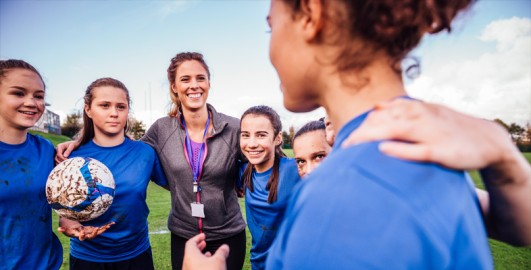3 Creating ‘safe spaces’ for neurodivergent athletes: pulling it all together
In previous sections of the course, you have heard how ‘safe’ spaces are a crucial part of ensuring that neurodiverse people feel welcome, accepted, and supported. A ‘call to action’ below highlights the role sports organisations have in responding to the needs of those within their communities:
… employers, such as sport governing bodies and sports clubs, have a responsibility to make reasonable adjustments to ensure their employees (e.g. athletes, coaches) have an inclusive and accessible workplace (e.g. designated quiet rooms with dimmable lighting).
This call carries additional weight as it is developed with neurodivergent athletes so has their experiences at the centre of it. The focus on ‘employees’ in this context should be widened to include volunteer roles of coaches and administrators in grass roots sport, alongside the needs of their athletes. These inclusive spaces are essential in helping athletes feel safe and welcome when they take part in their chosen sport, whether that be a training or performance setting.
Just like other emotions you have heard athletes share so far, feeling safe can of course mean different things to different people. Through creating safer spaces for athletes, we can help develop a supportive environment where athletes feel free from judgement, critical opinions, or micro-aggressions from coaches, fellow athletes or others which is of great importance for those like Lucy Bronze who may already feel marginalised (Mikami et al., 2019). Where coaches can foster these safe spaces, athletes are more likely to ask for help and support when needed. Importantly, you will also be positively impacting your athletes’ wellbeing.
Activity 4 Adjusting your practice
Listen to two clips from the podcast below, which discuss the potential adjustments neurodivergent athletes may need to help feel comfortable, supported and accepted. You will hear from former athlete Caragh McMurtry, journalist Nick Ransom, and community-based rugby coach Jacob Kelly.
Across both clips, what practical things are mentioned by Nick, Jacob and Caragh as helpful adjustments for neurodivergent athletes? Select which strategies you hear from the list below by adding a tick or X in the second column. Finally, rank each one you hear about in terms of how easy they could be to implement into your own practice, with 1 being the easiest and 8 being the hardest.
All about neurodiversity in elite athletes
Clip 1: 36:47–40:13
Clip 2: 53:26–1:02:02
| Adjustment | Present | Explanation | Rank |
| Sensory adjustments | Managing lighting or noise to support athletes. This can include allowing some to wear headphones or even sunglasses | ||
| Bland food | Where food and drink are available for players, bland options can help athletes manage feelings of sensory overwhelm | ||
| Simple things, more often | Making simple and easy to manage adjustments for both coach and athlete are not only easier to implement, but also easier to maintain | ||
| Fidget devices | Sometimes called fidget ‘toys’, these devices can provide a tactile distraction for an athlete to help them manage | ||
| Systemic changes | This refers to policy changes at organisational or club level which help coaches and families provide individualised support for athletes | ||
| Extra time for drills | In particular for ADHD or dyslexic athletes, this reflects the different way they may learn new skills, so a couple of minutes extra for a drill can make a huge difference | ||
| Work with families | Communicating with athletes and their families can mean any adjustments are reflective of each athlete's individualised needs | ||
| Awareness with neurotypical athletes | This can help reduce stigma associated with neurodivergent conditions, and reinforce sporting environments as safe spaces |
Comment
You will hopefully have recognised all of the adjustments from the table described in the podcast clips. What comes through strongly from the experiences described by the interviewees is not only the importance of recognising and supporting neurodivergent athletes, but also those individualised strengths-based approaches you have been learning about throughout the course.
